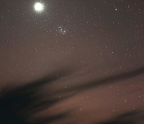Venusian cusps, caps and collars
Apr 06, 2022
4 minutes
by Thomas A. Dobbins

For telescopic observers, the dazzling face of Venus is a bitterly disappointing sight compared with the detailed disks of Mars and Jupiter. The planet’s surface is concealed from prying eyes by an unbroken canopy of clouds, overlaid by a thick haze. It’s not unusual for experienced observers working with powerful instruments to find Venus utterly featureless. The few visible markings are almost invariably diffuse, ill-defined shadings of very low contrast.
The preeminent 18th-century Venus observer Johann Hieronymus Schröter failed to detect any markings for nine years, until in 1788 he was finally able to glimpse
You’re reading a preview, subscribe to read more.
Start your free 30 days





